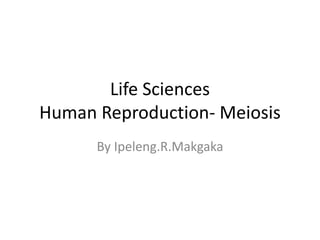
Meosis
- 1. Life Sciences Human Reproduction- Meiosis By Ipeleng.R.Makgaka
- 2. What is meiosis? • Meiosis like Mitosis is cell division • However meiosis is the process that converts diploid nuclei to a haploid nuclei. • In other words meiosis takes diploid body cell which has 46 chromosomes and converts it into a haploid sex cell which has 23 chromosomes.
- 3. Where does meiosis take place? • Meiosis takes place in the sex organs, producing gametes. • Gametes are sex cells: sperm or eggs. • Gametes have to be haploid so that once fertilization takes the haploid sperm can fuse with haploid egg to form diploid zygote. • Therefore a zygote has a diploid number of chromosomes, one set from each parent
- 4. A Life cycle
- 5. Meiosis consists of... • Meiosis consists of two stages namely, Meiosis I and Meiosis II • Meiosis I consists of five phases namely, InterphaseI, ProphaseI, MetaphaseI, AnaphaseI, TelophaseI. • Meiosis II consists of four phases namely, ProphaseII, MetaphaseII, AnaphaseII, TelophaseII.
- 6. Meiosis I- Interphase I • The cell builds up energy in order for DNA Replication to take place. • DNA is replicated to make sure that chromosomes are duplicated. • The cell does not change structurally.
- 7. Meiosis I- Prophase I • The chromosomes coil and become individual chromosomes. • The nucleolus and Nuclear envelope begin to disappear. • Homologous chromosomes come together and exchange genetic information through the process of crossing over. • This will ensure genetic variation. • The Centrioli moves towards opposite poles with spindle fibres between them.
- 8. Meiosis I- Metaphase I • The Centrioli has reached the poles. • The homologous pairs align at the cell equator. • The two chromosomes attach to one spindle fibre by means of the centromere.
- 9. Meiosis I- Anaphase I • The Spindle Fibres begin to contract. • This causes the duplicated chromosomes to move towards opposite poles
- 10. Meiosis I- Telophase I • The duplicated chromosomes have reached the opposite poles. • A nuclear envelope and nucleolus begin to re-form around chromosomes. • Cell devides forming 2 separate haploid cells
- 11. Meiosis II- Prophase II • Chromosomes coil and become compact if they uncoiled during Telophase I. • The nuclear envelope and nucleolus begin to disappear. • The Centrioli move to opposite poles, forming spindle fibres in between them.
- 12. Meiosis II- Metaphase II • The individual duplicated chromosome align along the equator. • One chromosome per spindle fibre are attached by means of the centromere. • The Centrioli has reached the opposite poles.
- 13. Meiosis II- Anaphase II • The spindle fibres contract causing duplicated chromosome to split in half. • These daughter chromosomes begin to move towards opposite poles
- 14. Meiosis II- Telophase II • Daughter chromosome reach the opposite poles. • The two cells invaginate and form four daughter haploid cells • They uncoil and form a chromatin network. • Nuclear envelope and nucleolus form around chromatin network again.
- 16. Difference between meiosis I and meiosis II Meiosis I Meiosis II Begins with Interphase= DNA Replication Begins with Prophase= No DNA replication Begins with Diploid number of chromosomes Begins with haploid number of chromosomes. Prophase consists of crossing over Prophase consists of no crossing over.
